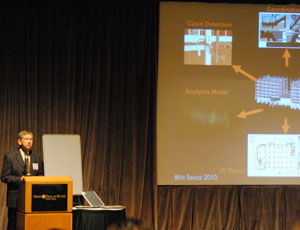Efficiency is not a word to describe traditional construction systems, says Jim Jacobi, senior principal and chief information officer with Houston-based Walter P Moore.

Delivering the keynote presentation at the two-day BIM Texas 2010 conference in Irving on Thursday, Jacobi touted the use of Building Information Modeling (BIM) in yielding significant results toward that effort. The event was jointly presented by TEXO, a construction association in Dallas and Texas A&M University.
Jacobi says Walter P Moore’s BIM implementation began in 2005. Today it includes upwards of 300 projects using BIM. And the firm is not alone. Jacobi cited McGraw-Hill Construction’s “The Business Value of BIM,” a SmartMarket report that states that about one-half of the industry has adopted BIM, a 75% increase from two years ago. The use by contractors has quadrupled in the past two years, and that utilization is projected to double in the next two years, he adds.
“BIM is becoming the gold standard by which firms do work. I’ve seen that ring true over the past few years,” he says. “The use of BIM is on the upswing. It’s not universal yet, but it is definitely making an impact.” He adds that project profitability “creeps up” almost 50% when using BIM.
At Walter P Moore’s Houston offices a “visionarium,” which Jacobi characterized as a mini-Imax theater, allows staff and clients to walk through a model, he says. Team members on health-care projects, facility owners, clinicians, hospital administrators and others can get involved early on, playing a role in the design in a way they could not working with flat drawings, he says.
One of most common challenges BIM addresses is clash detection. Typically the interferences among architectural, structural and mechanical elements are detected in the field. With BIM, these are eliminated before getting to construction, Jacobi says.
The information-packed digital assets produced during a BIM-based project have the potential to transform the way supply-chain partners work together to improve the design and construction process. This is accomplished by enabling early identification and removal of problems, resulting in cost and schedule benefits and assisting projects to avoid costly delays, Jacobi says.


Post a comment to this article
Report Abusive Comment